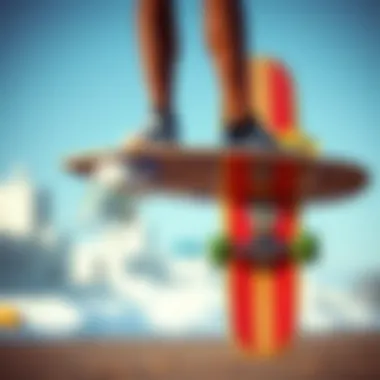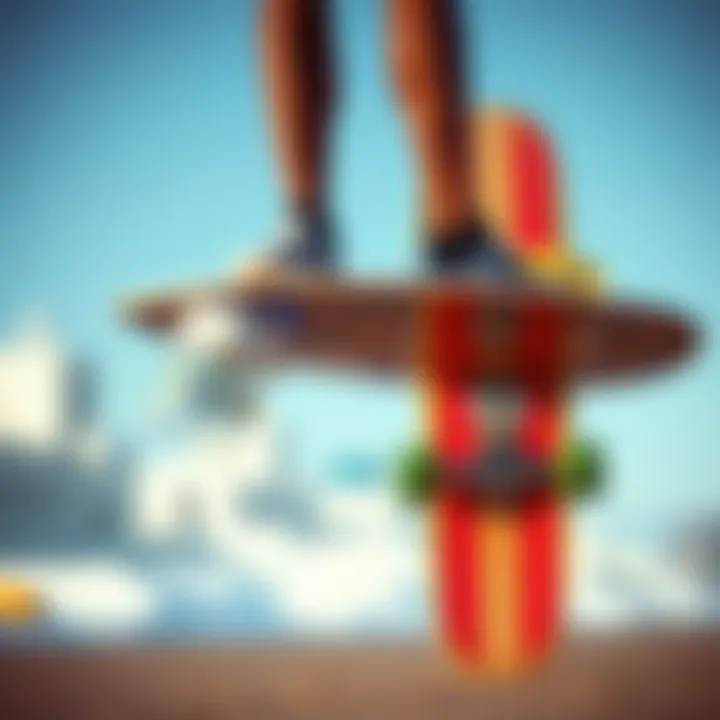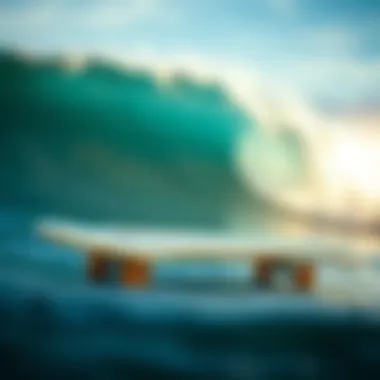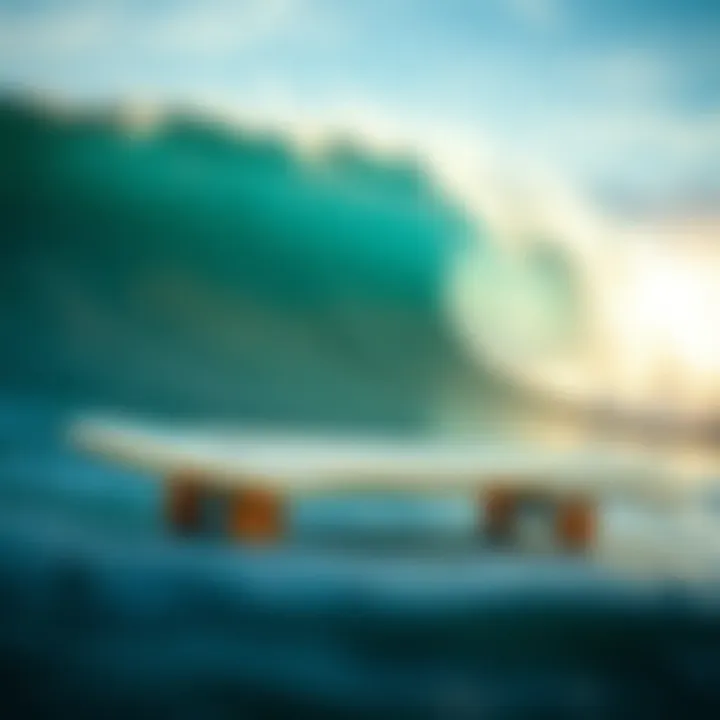Exploring Longboard Skate Decks: Types and Performance


Intro
Longboard skate decks represent a unique intersection of art and engineering. As both a practical tool for mobility and an expression of personal style, these decks have become essential for riders of all skill levels. The diverse range of longboard designs, materials, and shapes offer something for everyone—from the casual cruiser to the competitive downhill racer. This exploration aims to dissect these elements, delving into how they impact performance, aesthetics, and overall rider experience.
In the world of longboarding, the deck is more than just the board you stand on. It's the foundation that determines how smoothly you glide over pavement, tackle sharp turns, or even perform tricks. Various construction materials, from bamboo to fiberglass, can significantly alter the riding dynamics and durability of a deck.
Rider preference also plays a key role in selecting the right longboard. The shape of the deck and its length can cater to distinct riding styles, whether it’s carving your way down a hill or simply rolling down to the local cafe. The importance of understanding the nuances behind each aspect cannot be overstated, especially for those who want to elevate their riding experience from a mere hobby to an art form.
No stone will be left unturned as we discuss not just the innate characteristics of longboard decks, but also some maintenance tips and the common pitfalls that beginners might face. Additionally, I’ll introduce various brands and models that stand out in the competitive marketplace, making it easier for you to choose the best fit for your riding style.
With a comprehensive analysis at hand, riders will gain a clearer view of the longboard landscape, enabling them to make informed decisions and deepen their appreciation for this exhilarating sport.
Understanding Longboard Skate Decks
Longboard skate decks are at the heart of the longboarding experience. Understanding them goes beyond merely knowing how they look or where to buy one. It's about grasping the intricacies of design, functionality, and how these elements affect overall performance. The ride quality, stability, and maneuverability significantly hinge upon the deck's characteristics, making it essential for riders to select wisely.
When you delve into longboard decks, consider factors like the intended use, rider skill, and even personal style. Knowing the specifics can help a rider choose a deck that fits their individual needs rather than simply going for what looks flashy. Furthermore, a well-chosen deck not only enhances the riding experience but can also foster a deeper connection to the sport itself, making understanding these skate decks a worthy pursuit.
In addition, every rider might want different things from their board. Some might be after speed and stability for downhill races, while others may prioritize tricks and creativity when freestyling. This section is crucial for setting up the rest of the article, as it underlines the importance of how various factors intertwine to influence the ultimate longboarding experience.
Defining Longboards
Longboards are a variant of skateboards, typically longer and wider. This design lends to a more stable ride, which has made longboards particularly popular among those who like cruising, commuting, or even downhill racing. While the term "skateboard" usually brings to mind the trick-heavy streets of urban areas, longboards seem to have found their niche where comfort and style meet functionality.
They come in multiple shapes and sizes, designed to cater to varying terrains and riding styles. From concave shapes to flat designs, each board offers a different feel and capability. It’s like choosing between riding a bicycle or a motorcycle, both serve a purpose but cater to different experiences.
Longboarding has also seeped into various cultures, being seen in communities where transported goods or leisurely rides define daily life. To sum it up, longboards are more than just sporting equipment; they represent a lifestyle for some and a practical choice for others.
Historical Evolution
The history of longboards isn't so straightforward. It’s like tracing a complex family tree that branches out in numerous unexpected directions. Originating in the 1950s as surfboards adapted for land, longboarding began making waves as people sought fun ways to emulate surfing on solid ground.
In the early days, they were often homemade and varied wildly in shape and material, from wooden crates to repurposed surfboards. As decades rolled on, a clearer identity for longboards emerged. Manufacturers started focusing on quality, and innovations in materials paved the way for a variety of models built for different riding styles.
By the 1980s and 1990s, longboarding had carved out its own dedicated niche within the skating world. As a result, you began to see competitive racing events pop up, along with freestyle innovations that haven’t slowed down since. Today, the evolution continues, and new styles and techniques are born every vintage skate-meet.
Here’s a little food for thought: What if those early surfers never thought to adapt their sporting passion for the land? The longboard world might’ve looked rather different today.
The story of longboards is a testimony to human creativity. As longboarding thrives, it reflects an unyielding spirit of innovation, blending past inspirations with future possibilities.
Types of Longboard Skate Decks
Understanding the different types of longboard skate decks is crucial for any rider, as each style offers unique features that cater to specific riding preferences and environments. From cruising through busy streets to carving mountainsides, knowing the type of longboard that fits your style can greatly enhance your experience. Here we delve into four primary categories of longboard decks: Cruiser Longboards, Freestyle Longboards, Downhill Longboards, and All-Terrain Longboards.
Cruiser Longboards
Cruiser longboards are often seen as the go-to option for beginner riders or those just looking to get around comfortably. They are typically designed with a wider, longer shape, which allows for better stability and a smoother ride over rough or uneven surfaces. This type of longboard usually features a moderate concave that helps with foot grip, making it easier to push off and maneuver in busy areas.
"Cruiser longboards are for enjoying the ride, not just getting from A to B."
The benefits of cruiser boards include:
- Comfort: Wide decks provide ample foot space and stability.
- Ease of Use: Ideal for beginners, they require less technical skill.
- Versatility: Perfect for commuting, casual riding, or relaxed paths.
Their typically softer wheels allow riders to glide over bumps and cracks effortlessly. This makes them ideal for urban environments or neighborhood strolls, providing a laid-back vibe while riding.
Freestyle Longboards
Freestyle longboards tend to appeal to riders who want more than just travel; they want to express themselves. Designed for tricks and flips, these decks can be either symmetrical or directional. The flatter shape allows for better foot placement and balance. Riders can perform tricks and maneuvers similar to those on a skateboard, but with the added stability that a longboard provides.
Some standout attributes include:
- Lightweight Construction: Typically made of maple or bamboo for easy handling.
- Symmetrical Shape: Enables riding in both directions.
- Versatile Options: Allows for a variety of tricks, from slides to ollies.
With freestyle longboards, riders are encouraged to push their creativity and showcase their skills, making this style particularly popular among younger riders or those looking to hone their craft.
Downhill Longboards
If you are someone who craves adrenaline and speed, downhill longboards are the answer. These decks are built to slice through wind. They are longer, lower, and designed to offer superior stability at high speeds. Generally, the wheelbase is longer, providing more control when hauling down at breakneck speeds. Their sturdy construction minimizes the risk of wobbling, which can be vital for safety.
Key features of downhill longboards include:
- Aerodynamic Design: Shaped to reduce drag and enhance speed.
- Stiff Flex: Offers stability during high-speed rides and curves.
- Durable Wheels: Often larger and harder to roll over any rough terrain smoothly.
Perfect for mountain roads or steep declines, downhill longboarding is not for the faint-hearted. Riders need to possess good balance and control to make the most of this thrilling experience.
All-Terrain Longboards
All-terrain longboards are the jack of all trades of the longboarding world. They combine the features of multiple styles, allowing riders to adapt to various conditions—from pavement to dirt trails. Their unique design includes larger, softer wheels that can manage different types of surfaces with ease.
Benefits of all-terrain boards include:
- Versatility: Can be used on multiple surfaces, ideal for adventurous riders.
- Robust Construction: Built to withstand the demands of off-road conditions.
- Enhanced Comfort: Larger wheels provide a cushioned ride over rough terrain.
For those who love to explore beyond the limits of a regular street, this type opens up a world of possibilities.


Understanding these types of longboard decks not only enriches your knowledge but also helps you choose wisely based on your riding habits and preferences. Each type offers distinct advantages, highlighting the variety and richness of the longboarding experience.
Construction Materials for Longboard Decks
In the world of longboarding, the choice of deck material is crucial, as it significantly influences not just the aesthetics but also the performance, durability, and overall riding experience. Whether you are carving through urban streets or cruising along beachside paths, understanding the materials can help you select the right deck tailored to your style of riding.
When it comes to longboard skate decks, the most popular materials include wood, composite substances, and plastic. Each material presents its own advantages and drawbacks that can affect everything from weight to flexibility. This section will dive into the specifics of these materials, offering insights to both novices and seasoned riders alike looking for long-lasting quality in their gear.
Wood Decks
Wood has been the traditional choice for longboard decks for years. Typically made from maple or bamboo, wood decks bring a sense of nostalgia for many riders. The main attributes of wood decks are their strength and ability to absorb shocks, which makes for a smoother ride over uneven surfaces.
- Flexibility: Depending on the thickness and type of wood, decks can either be stiff or flexible. A flexible deck offers better shock absorption, while a stiff deck can provide more speed and stability.
- Aesthetics: There’s no denying the natural beauty of wood. The grains and colors of wood can really set a deck apart visually.
- Environmental Factors: Since wood is a natural material, its environmental impact can be both a pro and a con. Sustainable sourcing is key to balancing performance and ecological responsibility.
In summary, wood decks are a reliable option for riders seeking performance balanced with a classic aesthetic.
Composite Decks
Composite decks are crafted from a mix of materials – often layering fiberglass with wood or using high-tech plastics. This approach aims to combine the benefits of multiple materials. Here are some characteristics of composite decks:
- Durability: They tend to last longer than pure wood decks, thanks to their resistance to cracking and warping.
- Lightweight: Usually, composite decks are lighter than wood, making them easier to maneuver for tricks and agility-focused riding.
- Variety in Flex: These decks can be engineered for specific stiffness or flexibility, which allows riders to have a deck tailored precisely to their riding style.
For the rider looking for innovation and a touch of modern technology, composite decks offer a viable choice that doesn’t skimp on performance or versatility.
Plastic Decks
Plastic longboard decks, often made from materials like polypropylene, are gaining traction in the longboarding community. They offer distinct advantages that cater particularly to certain demographics. Let’s explore:
- Affordability: One of the most appealing aspects is the cost. Plastic decks are often much cheaper, making them accessible for new riders.
- Weather Resistance: They handle water like a champ, meaning rain or spills do not affect them negatively, unlike wood which can swell or warp.
- Lightweight: Plastic decks are incredibly light, which benefits transport and maneuverability. However, riders should always check for sturdiness, as thinner plastic options can bend under pressure.
While not traditional, plastic decks can serve a specific niche, particularly for casual cruisers or those just starting on their longboarding journey.
Ultimately, the choice of construction material for a longboard deck intertwines with rider preference and intended use. By understanding these materials and their characteristics, you can better navigate the market and find the perfect deck suited to your specific needs. As you explore various options, consider how each material aligns with your riding style and priorities, ensuring that your longboarding experience is not only fun but optimized for your skill level.
Design Profiles and Their Impact
The design profile of a longboard deck plays a critical role in determining not just how the board looks, but also how it performs. A solid understanding of these profiles helps riders make informed choices that suit their personal style and riding preferences. Deck design directly influences stability, speed control, and overall ride quality, serving as the backbone for various riding experiences — be it cruising along boardwalks, tackling downhill paths, or performing tricks at the skatepark. A distinctive shape can make or break a ride, which is why a rider's decision on a deck's design profile goes beyond aesthetics, intertwining with their riding goals, skill levels, and intended terrains.
Concave Shapes
Concave shapes contribute significantly to a rider’s balance and control. A concave deck will curve upwards from the center to the edges, creating a bowl-like shape. This design conforms to the rider's feet, providing a more secure footing and enhancing grip during turns and maneuvers. Depending on the depth of the concave, riders can experience varying levels of responsiveness. A deeper concave allows for tighter turns and nimble movements, which can be great for freestyle and trick riding. However, a shallower concave might be suited for cruising, as it offers more comfort over long distances.
"Choosing the right concave can feel like finding your perfect dance partner — you need to align with its strengths to enhance your ride."
Below is a breakdown of the types of concave shapes commonly found:
- Radial Concave: This is one of the most popular shapes, ideal for an all-around performance. It offers enough comfort for cruising while providing solid control for tricks.
- W Concave: With raised edges, this shape truly locks the feet in place, making it perfect for downhill riders who prioritize stability at high speeds.
- Symmetrical Concave: Evenly curved on both ends, it’s a favorite for freestyle longboarders who need to use the deck in whichever direction.
Camber Profiles
Camber profiles focus on how the board flexes under weight. This design entails an upward arc along the length of the deck, which therefor allows for a unique ride experience. When a rider puts weight on a cambered board, it causes the ends to rise, granting a spring-like effect. This added pop can be useful for jumps and tricks. For cruising, a camber profile also offers a comfortable ride as it absorbs bumps effectively.
However, one must be cautious with how a cambered deck handles speed as it can lead to a less stable ride compared to other profiles. Here’s a clearer look at camber types:
- Continuous Camber: A smooth upward curve that blends perfectly into the shape of the deck, helpful in generating smooth rides.
- Flat Camber: Lacking much curvature, providing an even feel while allowing a balanced stance, which benefits riders who enjoy switching between styles.
Flat Decks
Flat decks are, as the name suggests, devoid of any significant shape. They provide a stable platform, making them great for beginners and those past the learning curve who wish to focus on tricks. The simplicity of a flat deck allows for easier foot placement, granting beginner riders the confidence to find their footing. This design also lends itself well to sliding and can be more forgiving when it comes to foot positioning.
However, flat decks do come with trade-offs, especially in terms of performance in tighter turns. They might lack the grip offered by concave designs but can make up for it through ease of use and versatility.
When assessing flat versus concave designs, consider the following pros and cons:
- Pros of Flat Decks:
- Cons of Flat Decks:
- Easy foot placement.
- Great for learning tricks and slides.
- Usually more affordable.
- Less grip when maneuvering aggressively.
- Can feel less responsive compared to concave profiles.
Understanding these design profiles enriches the experience. No matter the chosen design, knowing the implications behind each can transform a rider's approach to longboarding, shaping not just their skills, but also the enjoyment of each ride.
Performance Factors Influenced by Deck Design
Understanding how deck design influences performance factors is crucial for longboard enthusiasts. The interaction between design elements and performance can radically affect your riding experience. Different types of longboard decks serve varying purposes, and the relationship between design choices and performance can be the difference between a smooth ride and a bumpy one. Deck shape, flex, and material all play significant roles in shaping these performance factors.
Stability
Stability is essential, especially when riding at high speeds or tackling tricky terrains. A longboard designed with a wide platform typically provides better stability. When the deck is wider, it disperses your weight more effectively and lowers your center of gravity. This is particularly evident in downhill longboards where speed is the name of the game. Riders want to feel grounded, and a stable deck allows one to tackle curves and uneven surfaces with confidence.
A noteworthy point is that also the wheelbase varies with the design. A longer wheelbase generally increases stability while making tricks harder. Shorter wheelbases are often preferred for tricks but compromise stability. This balance is something each rider must weigh based on their personal preferences and riding style.
"A stable deck can mean the difference between a smooth ride and a sudden spill; it's all about keeping your balance."
Speed


Speed is the heartbeat of longboarding. Riders chase it, testing the limits of both themselves and their boards. The design of a board significantly impacts how fast you can go. Generally, decks that are stiff provide less flex, which can enhance speed as they allow for a more efficient transfer of energy to the wheels. Meanwhile, a flexy board can absorb some energy during pushes, where speed is sacrificed for comfort or control.
Aerodynamics also come into play. A tapered nose and a streamlined profile may reduce drag, making it easier to cut through the wind. Furthermore, achieving speed also depends not just on the deck but also on wheel hardness and material selection. Softer wheels provide more grip at lower speeds, while harder wheels tend to roll smoother at higher speeds. There’s a science to the glide, one that often requires experimentation and adjustments.
Control
Control encapsulates the rider’s ability to maneuver effectively. A board that excels in control tends to be shorter, with a more responsive design. Concave decks are particularly notable for improving foot grip, allowing the rider to shift their weight precisely when carving or executing tricks. The depth of the concave influences how much control a rider feels underfoot. A deeper concave lends itself to more confident carving, while a shallow one may require extra effort for sustained edging.
Additionally, your choice of trucks affects control, too. Wider trucks can provide more stability, which might suit beginners, while narrower ones give more agility for experienced riders. The interplay between the deck design and these external components can lead to a tailored experience that reflects the rider’s style and needs. Thus, a well-balanced longboard allows the rider to feel in command of their path.
In summary, performance factors influenced by deck design notably encompass stability, speed, and control. As riders evaluate their options, selecting a deck that aligns with their performance goals can lead to more fulfilling and safer rides.
Rider Preferences and Longboard Choice
Choosing the right longboard isn’t just about picking something that looks good or seems trendy. It’s a thoughtful decision that intertwines a rider's personal style, skill level, and intended use. Every rider is unique, meaning each will have different expectations and preferences when it comes to their longboarding experience. Acknowledging these preferences plays a key role in enhancing the overall enjoyment and performance of riding.
Understanding the alignment between a rider's preferences and the longboard they choose is crucial. For instance, riders who prioritize cruising will need a different deck than those looking to tackle downhill races. This alignment can affect everything, from stability to speed, and even how comfortable the rider feels. Let's break this down into two pivotal components: skill level considerations and intended use.
Skill Level Considerations
When it comes to skill level, one size doesn’t fit all. Beginners might want to lean towards wider decks with a softer flex, as these features promote stability and easier rides. On the other hand, more seasoned riders often seek decks that are stiffer, which provide enhanced responsiveness and tighter turns. An experienced rider's familiarity with their board's dynamics informs their style, from cruising to downhill racing, each of which may require a distinct board.
In addition, the material construction can also influence performance. For example, a novice rider might find it intimidating to ride a carbon fiber deck designed for high-speed cruising. A plywood board, with its forgiving nature, can usher in a sense of confidence in new riders. Consider this information when selecting a longboard:
- Beginner riders: Look for wider decks, softer flex, and a stable base. Best options are usually made of wood.
- Intermediate riders: Explore various flex options and shapes that align with speed and stability. Composite materials might serve well here.
- Advanced riders: Often gravitate towards stiff digital designs and materials. This cohort typically seeks sheer performance.
Intended Use
The purpose behind the longboard also shapes the decision-making process. Are you looking to simply cruise around the neighborhood, or do you want to shred downhill at breakneck speeds?
Here’s a quick snapshot of how different riding styles impact longboard choice:
- Cruiser Longboards: Typically feature a relaxed shape and a flexible framework, catering to leisurely rides. They are broader, offering more surface area and a steady feel.
- Freestyle and Trick Longboards: These are often shorter and stiffer, ideal for performing manouvers and tricks. Riders here focus on balance and agility, necessitating responsive decks.
- Downhill Longboards: These must be crafted for speed and stability. They tend to have lower profiles, ensuring riders can carve effectively without sacrificing control.
- All-Terrain Boards: Perfect for riders who want to tackle varied surfaces. They typically boast thicker wheels and an ultra-durable design.
In summary, understanding both skill level and intended use stands as a precursor to longboard choice. As riders consider what's best for them, the path to finding that perfect deck unfolds naturally, setting the stage for countless exhilarating rides.
"Choosing the right longboard is more than just a purchase; it defines the journey of every ride and shapes the experience each time you hit the pavement."
For more details on selecting longboards suited for different skill levels or intended use, you can refer to resources like Wikipedia or discussions on Reddit.
Understanding these key elements not only enhances individual rides but also fosters a deeper connection between the rider and their longboard.
Maintenance and Care of Longboard Decks
Taking care of your longboard deck is no small feat, but it is absolutely necessary for prolonging its life and keeping your rides smooth and enjoyable. Skating on rough terrain, hitting all kinds of weather, and just the wear and tear of regular use can take a toll on even the toughest decks. Understanding how to maintain your longboard effectively not only helps in preserving its structural integrity but also enhances performance, safety, and overall riding experience.
Effective maintenance involves a few key practices that one should adopt as a routine. A clean deck helps boost its longevity and functionality. Regular checks for potential damage prevent small issues from escalating into bigger ones, which can lead to costly repairs or even accidents while riding.
Cleaning Techniques
When it comes to cleaning your longboard deck, less is sometimes more. Here are some basic steps to keep your board in tip-top shape:
- Wipe Down After Use: After a ride, take a cloth and wipe down the top and bottom of the deck. This removes dirt, grime, and other residues you've picked up on your ride.
- Use a Soft Brush: If your deck is particularly dirty, a soft brush can help dislodge any stubborn particles. Grit can cause scratches over time, so best to get it off before it embeds.
- Mild Cleaners: Opt for mild soap mixed with warm water to scrub off tougher stains. Avoid harsh chemicals, as they can damage the finish and the materials underneath.
Remember, while a clean deck looks good, a well-maintained deck rides better.
Inspecting for Damage
Performing regular inspections is crucial for any skateboarder serious about safety and preserving their gear. Look for:
- Cracks and Chips: Check the edges and bottom side of the board for any visible cracks or chips that could affect performance. Even the smallest defect can lead to larger problems.
- Delamination: If you notice layers of the deck separating, that’s a sign of trouble. Delamination occurs due to moisture or physical impact and needs to be addressed quickly.
- Wheel and Truck Alignment: Besides the deck, always ensure that wheels are securely attached and that the trucks are properly aligned. Misalignment can result in uneven wear and tear.
Conducting these checks can save you from potential dangers while riding, along with ensuring your board performs at its best.
Repairing Minor Issues
Not every scratch or dent warrants a trip to a professional. Many riders can handle minor repairs themselves:
- Fill Cracks: Small cracks can be filled with wood glue or epoxy resin. Be sure to sand it down smooth after it dries to maintain a good finish.
- Reapply Finish: If the finish is scratched or faded, using a similar varnish or sealant can restore it and protect the wood underneath.
- Replace Worn Parts: If the wheels or trucks are looking a bit worse for wear, replacing them can significantly affect your ride. Replacement is usually straightforward and worth the effort.
By keeping a keen eye on your longboard’s condition and quickly addressing any issues, you ensure that your investment remains valuable and your riding experience remains enjoyable. Proper maintenance contributes to safety, performance, and longevity in ways that are sometimes not visible right off the bat.
"An ounce of prevention is worth a pound of cure." This saying holds especially true for longboard care; a little maintenance goes a long way.
Common Issues and Solutions
When you glide down the streets or carve through hills on a longboard, the excitement is palpable. However, just like any sport gear, longboards come with their own set of potential hiccups. Understanding common issues and the solutions to these can save riders not just money but also the joy of an uninterrupted session. It’s well worth your time to know what to look for!
Warping
Warping is a frequent concern for longboard enthusiasts. You might notice that your deck looks bent or twisted, and that can throw a wrench into your riding experience. Their shapes and rigidity can change due to temperature fluctuations, moisture, or simply age. As wood absorbs water, it may swell and lead to warped decks—nobody wants to feel like their board can’t handle the turn!
To avoid this, riders must ensure proper storage. Here are some pointers:
- Store in a Dry Place: Keep your longboard in a dry area where humidity is controlled.
- Away from Direct Heat: Do not leave your board in a hot vehicle or direct sunlight; the heat can warp your deck.
- Regular Inspections: Examine your board frequently for early signs of warping. It’s like your body—it needs regular check-ups too!


If warping does occur, consider gently applying heat from a hairdryer or using clamps to reshape it. Just be cautious to avoid overheating the wood, as that could lead to further damage.
Delamination
Delamination is another nasty issue longboarders might run into. This is when the layers of the deck begin to separate, which can happen in composite decks especially. It often results from prolonged exposure to moisture or water, and once it begins, a ripple effect can occur, leading to significant concerns over strength and durability.
To fight off delamination, here’s some advice:
- Avoid Wet Conditions: Riding in the rain may feel liberating but can harm your deck in the long run.
- Use Protective Coatings: Applying a sealant can help in repelling moisture, so your longboard remains intact for longer.
- Stay Alert for Sounds: When you ride, listen for any unusual sounds like cracking which might point towards early stages of delamination.
If you do find your board is delaminating, consider using epoxy glue for repairs. Just keep it clean and ensure the area is well-prepared for adhesive to work its magic.
In essence, knowing these common issues and ways to tackle them can elevate your riding experience. Keep your longboard in tip-top shape, and you’ll enjoy smooth rides and fewer worries, letting you focus on that exhilarating feeling of cruising down your favorite path.
Brand Recommendations
Selecting the right longboard is crucial for both performance and enjoyment, and that’s where brand recommendations come into play. Well-known brands typically carry a reputation built on quality, innovation, and reliability. In a market saturated with options, turning to trusted manufacturers can greatly ease the decision-making process for both newcomers and seasoned riders alike.
Understanding the key features of a brand can help you determine whether their longboards align with your riding style. These characteristics often include the materials used, deck design, and customer service. It’s important to consider not just the aesthetics or price but also the durability and performance characteristics that a brand consistently delivers.
Some brands have made their mark by focusing on specific types of longboarding, such as downhill racing, cruising, or freestyling. Knowing which manufacturer specializes in your intended riding style can guide you towards an informed choice. Additionally, the presence of warranties and customer support can serve as a safety net, giving you peace of mind about your investment.
Top Manufacturers
One glance at the longboarding scene, and a few names quickly come up to the forefront. These manufacturers have cultivated a strong reputation over time, offering products that riders trust:
- Land Yachtz: Known for vibrant designs and durable decks, they've carved out a niche particularly in the cruiser segment.
- Sector 9: A staple for those interested in downhill and cruising, their boards are engineered for speed and stability.
- Arbor: They emphasize sustainable materials and environmentally-friendly practices, appealing to eco-conscious riders.
- Madrid Skateboards: An old name in the game, Madrid offers a mix of classic and modern designs aimed at a diverse range of skaters.
These companies not only make standout products but also foster communities around their brands, encouraging riders to connect and share experiences. It’s also worth keeping an eye out for collaborations with professional skaters that often yield unique, high-performing models.
Emerging Brands
While established names dominate the market, several emerging brands are worth paying attention to. These smaller companies often introduce innovative designs or materials that have a fresh take on longboard technology. Here are a few to watch:
- Landyachtz: Not to be confused with the first mention, this one focuses more on compact, portable boards designed for urban commuting.
- Penny Skateboards: Although known for their plastic cruisers, they are starting to dip their toes into longboarding, offering unique versatility in their designs.
- Sublime: This brand captures the essence of cultural artistry, marrying functional longboarding with eye-catching aesthetics.
- Bustin Boards: Pushing the envelope on custom-built boards, they cater to advanced riders seeking a unique experience tailored to their preferences.
As you explore the market, keep an open mind toward these emerging brands. Many offer competitive pricing and a chance to experiment with cutting-edge designs you might not find among larger companies. This can lead to discovering your new favorite ride.
"Navigating the longboard landscape can be tricky, but recognizing key brands can significantly simplify your search for the perfect deck."
By understanding the landscape of both established leaders and fresh contenders, you equip yourself with the knowledge to select a longboard that truly resonates with your personal riding style.
The Future of Longboard Deck Technology
As the world inches closer to technological marvels, longboard deck technology is not being left behind. This section aims to illuminate the potential of emerging advancements that promise to revolutionize the riding experience. Riders, both seasoned and novices, can expect significant benefits from these technological innovations, influenced by the demands of performance and sustainability.
Innovative Materials
The materials used in constructing longboard decks have advanced significantly. Traditional wood still holds its charm, but now enthusiasts are looking for a balance between performance and eco-friendliness. Here are some noteworthy advancements:
- Bamboo: Lightweight yet strong, bamboo has gained traction. It has a natural flex, providing both durability and comfort.
- Fiberglass: Often combined with wood or foam, fiberglass decks are popular for their high strength-to-weight ratio. They offer a responsive feel, making them ideal for downhill rides.
- Carbon Fiber: As one of the strongest materials available, carbon fiber allows for thinner decks without compromising strength. This is particularly appealing for precision riders who appreciate speed without added weight.
"The right material can change how a board rides, ultimately matching the rider's ambition and skill level."
Design Advancements
As important as the materials themselves, design is a crucial element linked to rider experiences. Deck shapes, widths, and profiles have evolved to enhance functionality. Some points to ponder include:
- Drop-Through Designs: These keep the rider's center of gravity low, improving stability and control, making them gifted for downhill racing or cruising.
- Wider Boards: Increased width allows for a more stable ride, particularly favored by beginners or those who prefer a leisurely experience.
- Custom Graphics and Personalization: With advancements in printing technology, riders can now enjoy personalized designs, turning their longboards into a unique extension of their identity.
The future of longboard deck technology dawns on a new horizon, offering innovative materials and design enhancements that cater to the evolving preferences of riders. With sustainability at the forefront, it’s clear that the journeys ahead will likely offer experiences that are not only exhilarating but also mindful of our planet's resources.
For further exploration on materials and their impacts, check useful resources such as Britannica or delve into discussions on Reddit for community insights.
The End
As we wrap up our exploration of longboard skate decks, it becomes clear that understanding the nuances of these boards is vital for both new and seasoned riders. The conclusion of this article underscores not just the individual aspects of deck types, materials, and designs, but also the broader picture of how these elements weave into the rider’s overall experience.
Importance of Deck Characteristics
Longboard skate decks aren’t merely a platform for wheels and trucks; they significantly affect performance and the enjoyment of skating. The shape of the deck, the material it’s crafted from, and its design profile all contribute to ride quality. For instance, while one rider might prefer a flexible, wooden board perfect for cruising, another may seek the rigidity of a composite deck ideal for downhill racing. With this diversity in offerings comes the need for informed choices that correspond to one's skating style and environment.
Benefits of Informed Choices
Choosing the right longboard can mean the difference between a delightful ride and a frustrating experience. Key benefits include:
- Enhanced Performance: Understanding how deck design affects stability and speed can improve your riding.
- Increased Safety: Knowing the characteristics of your board can reduce the chances of accidents, especially when navigating tricky terrain.
- Longevity: Proper care and maintenance of the deck promote durability, saving riders from frequent replacements.
Considerations When Selecting a Deck
When choosing a longboard, several considerations should guide the decision:
- Riding Style: Does the rider prefer cruising through urban landscapes, executing tricks, or tearing down hills?
- Skill Level: Beginners may want boards that are forgiving and easy to control, while advanced riders might seek performance-oriented designs.
- Terrain: The surfaces on which the longboard will be used also play a big part in the appropriate choice of deck material and profile.
"The beauty of riding lies not just in the journey, but in selecting the right board that resonates with your individual style and needs."
Overall, the final part of this article is not simply a summary but a reflection on how understanding longboard skate decks helps shape a better ride. As the industry continues to evolve with new technologies and materials, it becomes increasingly important for riders to stay informed. The insights gained serve not just to enhance personal enjoyment but to deepen one’s connection to the sport itself.
Key Takeaways
- Longboard decks come in various types, materials, and designs, each suited to different riding styles.
- The right longboard can significantly enhance performance, safety, and longevity of use.
- Informed decision-making is crucial; consider riding style, skill level, and terrain before selecting a deck.
In summary, this article aims to enrich the reader’s knowledge, ultimately leading to a more fulfilling longboarding experience.















